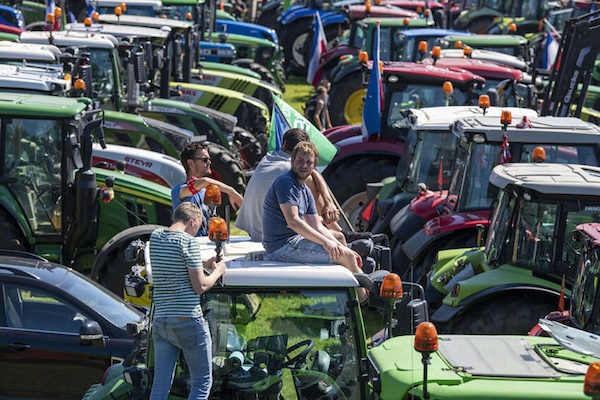Farmers in the Netherlands have been blocking roads and disrupting food distribution for weeks now in protest of “unrealistic” climate policies. Their specific point of contention is a government plan to cut nitrogen emissions in half by 2030. In some extreme cases, the emission cuts imposed on farmers could be as high as 95 percent, which would essentially mean an end to farming operations altogether. Some fear the conflict could be a sign of things to come across Europe as more governments eye a zero-emissions future.
The Dutch government based its targets on current European Union rules designed to reduce nitrogen pollution. For the sake of clarity, “nitrogen” is an umbrella term that includes both nitrogen oxide and ammonia. According to the Netherlands’ Central Bureau of Statistics, the country’s farms are responsible for 85% of ammonia emissions and 40 to 45% of overall nitrogen emissions. By their own estimates, the Netherlands has the second-highest emissions of ammonia per acre in the EU.
Dutch agriculture is a lot different than here in the U.S. For starters, the entire country is just a little bigger than the state of Maryland. At the same time, the country is second largest food exporter in the world, behind only the U.S. The bulk of ag exports are flowers and plants but dairy and meat exports are also huge. Overall, the agricultural sector contributes some 6.4% to the Netherland’s GDP.
The country’s enviable productivity is the result of some of the most efficient farming practices in the world. Those practices are also among the most intensive in the world, particularly animal farming. The country of approximately 17 million people keeps around 100 million chickens, 11.4 million pigs, and 3.8 million cows on approximately 30,000 farms. Dutch consumers subsequently spend only 8% of their income on food, one of only 8 countries (including the U.S.) in the world that spend less than 10% of annual household income on food.
The Netherlands also has 162 so-called Natura 2000 areas, which is a network of designated areas across the EU where certain species of animal and their natural habitats are protected. These conservation areas are the crux of what environmentalists have dubbed the “nitrogen crisis,” as excess nitrogen deposits can disrupt those ecosystems. Farms are blamed for 60% of nitrogen deposits in the Netherland’s conservation areas. Now, depending on a farm’s proximity to these conservation areas, farms must cut nitrogen emissions by 12 to 70 percent. Those situated in Natura 2000 areas would have to cut emissions by up to 95%, which most say would make it impossible to continue farming.
The Dutch government calls its plan an “unavoidable transition” and fully acknowledges that “there is not a future for all farmers” within the parameters. Dutch farmers are given basically three options: become more sustainable, relocate, or quit farming. The government has made a €7.5 billion buy-out program available but according to officials, there has been little interest from farmers.
LTO Nederland, the organization for agriculture and horticulture in the Netherlands, described the nitrogen reduction target as “simply unfeasible” and estimates some 30% of farms will be driven out of business. LTO and other ag advocates argue that the EU’s one-size-fits-all climate policies also discount what farmers actually do – feed people. Meaning the same rules imposed on other industries should not apply to farmers.
Concerns are also growing amid farmers in other EU countries over policies being eyed by their governments that they fear would similarly threaten their livelihoods. Farmers in Germany, Italy, Poland, Spain, and other EU countries have even launched protests in a show of solidarity with their Dutch counterparts. As the unrest grows, some are now worried that the protests could create a new food security crisis on the continent. Those that are protesting argue that the EU’s climate policies themselves are the real food security risk. (Sources: The Guardian, Bloomberg, The Economist, DeepDive)








